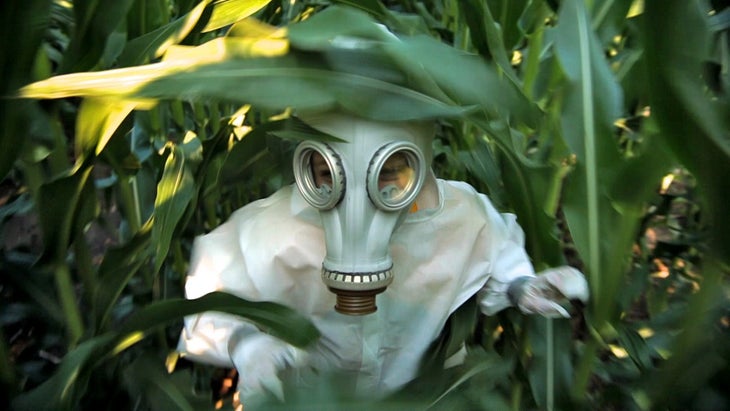Heading out the door? Read this article on the new Outside+ app available now on iOS devices for members! Download the app.

Watching the documentary GMO OMGreminded me of a rallying cry heard in the late ’60s and early ’70s, “The personal is political.” Yes, filmmaker Jeremy Seifert takes the condescension of the biotech industry personally, but that’s kind of the point. You almost forgive his turning the camera on his three adorable children since he sees their future at stake. Here, more of Seifert’s perspective on a few relevant issues: seed saving, the labeling of GMOs, and celebrating Halloween.
You say in GMO OMGthat having children causes you think more about food and the consequences of GMOs. But it’s also harder for families with kids to opt out of culture, as the film shows with the celebration of Halloween. How can parents reconcile those pressures?
It may be more difficult for parents to find a balance in the current food landscape, but we all have to reconcile our daily living with this fact from Wendell Berry: “How we eat determines, to a considerable extent, how the world is used.” I think we’re all finally understanding that what we consume affects the world, not just the environment, but also real people. When we buy and eat something, we support an entire system behind it, a way of interacting with the world and each other.
I chose to include a scene from Halloween in the film because it represents that tension between wanting to be healthy and raise our children likewise, but also not wanting to completely ostracize ourselves from friends, family, and the world around us. And, unfortunately, the “world around us” in the United States is absolutely filled with GMOs and chemically soaked food brought to us by giant agrochemical companies.
So here’s what we did. We had a great Halloween night with our friends, and the kids dressed up and experienced the strange and wonderful phenomenon of perfect strangers loving on them and filling their bags with delicious candy. And yes, they did eat some of it! But the next day we made them an offer: give us all your candy, and we’ll take you to that cool toy store you love and you can pick out something for $20 or less. We had three sacks of candy in an instant, which went into the trash. It’s not a perfect scenario by any means, but it’s an example of creative steps to take as we find our way out of this mess.
How has GMO technology attracted more attention than seed saving to ensure our future food security?
I don’t think that GMO technology has necessarily attracted more attention; it has simply taken over. This technology has grown out of the modernization of agriculture, and that’s when farmers began saving fewer and fewer seeds of the main staple crops. We have lost upwards of 90 percent of our crop varieties in the U.S. over the last one hundred years. This is the price we pay when the “advances” of science and the “progress” of the economy tell farmers: “Get big or get out!”
There is good news, though. Seed saving is alive and well, and it’s growing along with the rise of farmers’ markets and the movement for food sovereignty and local food cultures. Places like Seed Savers Exchange, Baker Creek Heirloom Seed Co., and many others are helping us appreciate seeds again and encouraging us to try our hands at planting some!
The European Union established labeling of GMOs in 1997. What’s different in the U.S. that’s resisted labeling?
In short, the people in the EU, and the media in the EU, were paying more attention. They had conversations about this new type of food and what it meant, and they demanded labeling. In the U.S., after GMOs have been on the market for over 15 years, people still don’t know what they are or have never heard of them.
The big question currently for all of us in the U.S. is this: Do we have the wakefulness and willpower to stand up for the basic right to know? To achieve this, we have to fight for the labeling of GMOs, and that fight is happening right now in states across the country. The biggest push happened in the fall of 2012 with California’s Proposition 37. Over 6 million people voted for their right to know, but the pesticide and junk food industry (companies like Dupont, Monsanto, Pepsi, and Coca-Cola) spent over a million dollars a day on deceptive ads in the last month to narrowly defeat the proposition. However, no one in the movement saw it as a defeat. They had exposed the industry’s fear of labeling and willingness to spend millions to keep us in the dark, and they raised consciousness across the nation, paving the way for labeling efforts around the country. Connecticut and Maine have already enacted mandatory GMO labeling, as long as bordering states do so, and Washington State’s I-522 ballot initiative is the battle that promises to blow the issue wide open this year.
In November the people of Washington will vote for their right to know, but they will be voting for all of us, and thus all of us should donate and volunteer. A victory in Washington, close on the heels of victories in Connecticut and Maine, will force “Big Food” to accept that labeling GMOs at the national level is inevitable and cut a deal with regulators (the FDA in this case), as happened in Europe.